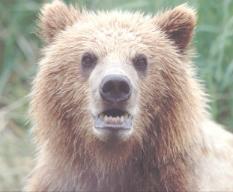
These photos of a grizzly track were taken by Scott Fisher, Washington DNR, in the Pend Oreille area of eastern Washington. The first photo is a front track and the second photo is a rear track.


This photo of a black bear track was taken near Loup Loup Pass in Okanogan County.

Alas, a good track is not what you always get. Many times it is a partial track or the features of the track are distorted by the terrain. To be so heavy, bears can tread very lightly.
 The above photo was sent to us as a possible grizzly track. It was passed around and the responses were quite interesting. No supporting information other than the photo was given to those responding. Judge for yourself:
The above photo was sent to us as a possible grizzly track. It was passed around and the responses were quite interesting. No supporting information other than the photo was given to those responding. Judge for yourself:“It strikes me as a black bear that is turning to its left dragging claw marks in the mud. I think I see the same holes just ahead of the toe pads that may have been the claw marks when the foot was first planted. Those marks appear to be only about 0.75 inch out from the toe. The pad width appears to be no more than 4 inches and this would suggest, if grizzly, a bear that is 2 years old or less and at least somewhat likely to be accompanied by a mother or siblings. All considered, it appears to be a black bear.” - US Fish and Wildlife Service
“Definitely a challenge. Tough to say where the bottom of the outside toe starts, which affects the line test. Also, I'm thinking the three longer claw marks may be a result of those claws being dragged, rather than the actual claw impressions. If so, then the actual claw marks are more consistent with black bear.” – Washington Dept Fish & Wildlife
“It suggests a black bear walking in slickey muck. The overall arc of the paw & toes supports this, as does the line test (allowing for slippage & sometimes toes aren't all over or all under the line). The claws most likely show up because it's in oozy goo, and the bear dragged its foot a little as it walked on. One can see the results of that on all 5 toes.” – National Park Service
“Tracking is something I can talk about, as a life-long tracker, and I agree that it is a black bear. The track has a counter-clockwise rotational torque on the foot caused by a slick surface.” - US Fish and Wildlife Service
To properly analyze a track many experts will carefully photo the track, then draw a picture and carefully measure all dimensions of the track. For a permanent record, a plaster casting can be made.
